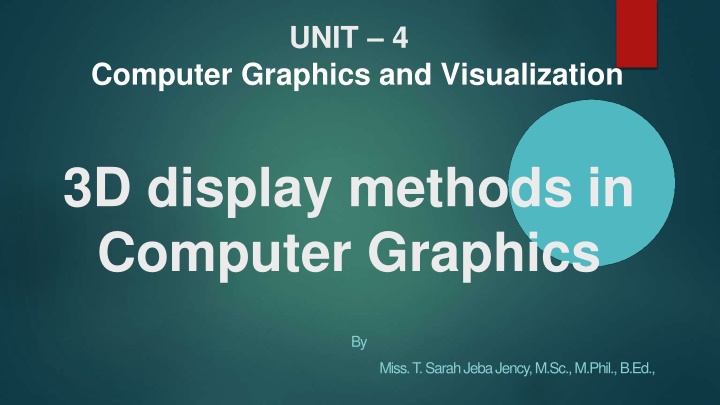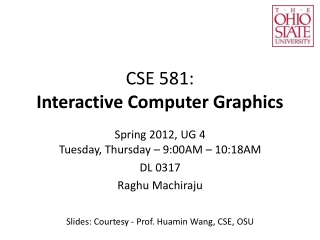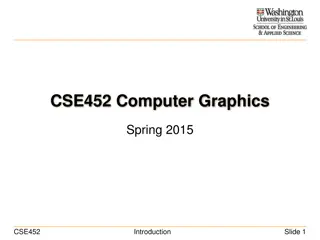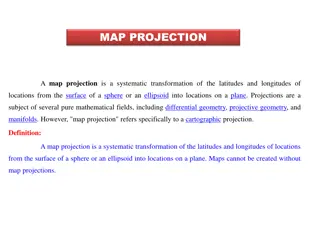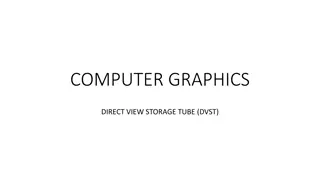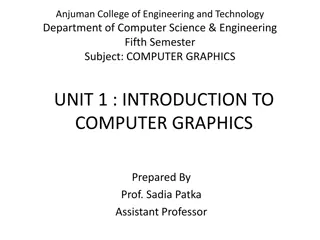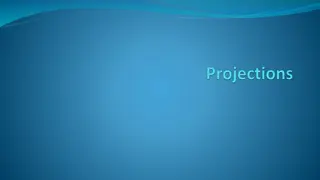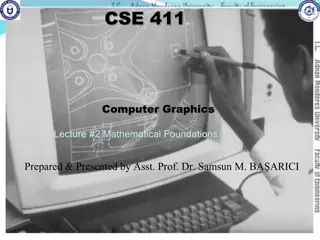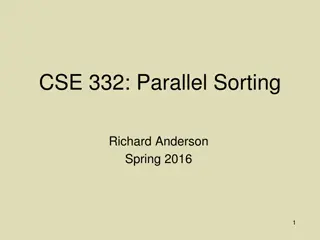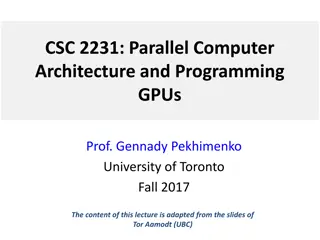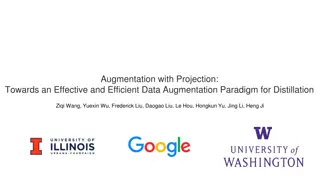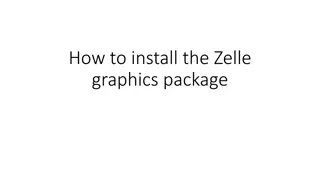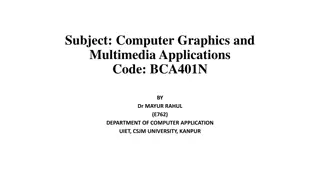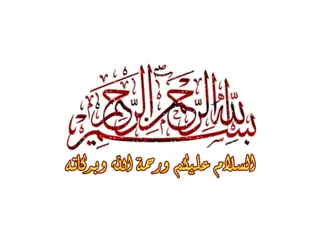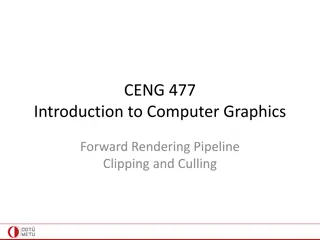3D Display Methods in Computer Graphics: Parallel vs Perspective Projection
3D computer graphics utilize a three-dimensional representation for rendering images. This article discusses parallel and perspective projection methods, highlighting their differences in preserving proportions and creating realistic views. Parallel projection maintains relative proportions, while perspective projection provides depth perception but may introduce ambiguity. Depth cueing and different types of perspective projections are also explored.
Download Presentation

Please find below an Image/Link to download the presentation.
The content on the website is provided AS IS for your information and personal use only. It may not be sold, licensed, or shared on other websites without obtaining consent from the author.If you encounter any issues during the download, it is possible that the publisher has removed the file from their server.
You are allowed to download the files provided on this website for personal or commercial use, subject to the condition that they are used lawfully. All files are the property of their respective owners.
The content on the website is provided AS IS for your information and personal use only. It may not be sold, licensed, or shared on other websites without obtaining consent from the author.
E N D
Presentation Transcript
UNIT 4 Computer Graphics and Visualization 3D display methods in Computer Graphics By Miss. T. Sarah Jeba Jency, M.Sc., M.Phil., B.Ed.,
What is 3d display methods in computer graphics? 3D computer graphics (in contrast to 2D computer graphics) are graphics that utilize a three dimensional representation of geometric data that is stored in the computer for the purposes of performing rendering 2D images. Such images may be for later display or for real-time viewing. We are talk about the followings. calculations and Parallel Projection. Perspective Projection. Depth Cueing
Parallel Projection: A parallel projection is a projection of an object in three-dimensional space onto a fixed plane, known as the projection plane or image plane, where the rays, known as lines of sight or projection lines, are parallel to each other. We connect the projected vertices by line correspond to connections on the original object. As shown in next slide a parallel projection preserves relative proportions of objects but does not produce the realistic views. segments which In parallel projection, z co-ordinate is discarded and parallel, lines from each vertex on the object intersect the view plane. are extended until they Notes: Project points on the object surface along parallel lines onto the display plane. Parallel lines are still parallel after projection. Used in engineering and architectural drawings. Views maintain relative proportions of the object.
Perspective Projection : The perspective projection, on the other hand, produces realistic views but does not preserve relative proportions. In perspective projection, the lines of projection are not parallel. Instead , they all converge at a single point called the center of projection or projection reference point . The perspective projection is perhaps the most common projection technique familiar to us as image formed by eye or lenses of photographicfilm on perspective projection.
Projection reference point : The distance and angles are not preserved and parallel lines do not remain parallel. Instead, they all converge at a single point called center of projection or projection reference point. There are 3 types ofperspective projections:- One point perspective projection is simple to draw. Two point perspective projection gives better impression of depth. Three point perspective projection is most difficult to draw. Some points about Perspective Projection : The perspective projection conveys depth information by making distance object smalls than near one. This is the way that our eyes and a camera lens form images and so the displays are more realistic. The disadvantage is that if object have only limited variation , the image may not provide adequate depth information and ambiguity appears.
Depth Cueing : Depth cueing is implemented by having background color with increasing distance from the viewer. The range of distances over which this blending occurs is controlled by the sliders. objects blend into the Tocreate realistic image, the depth information is important so that we can easily identify, for a particular viewing direction, which is the front and which is the back of displayed objects. The depth of an object can be represented by the intensity of the image. The parts of the objects closest to the viewing position are displayed with the highest intensities and objects farther away are displayed with decreasing intensities. This effect is known as depth cueing . Note: To easily identify the front and back of display objects. Depth information can be included using various methods. A simple method to vary the intensity of objects according to their distance from the viewingposition. Eg: lines closest to the viewing position are displayed with the higher intensities and lines farther away are displayed with lower intensities.
Visiblelineand surfaceidentification When we view a picture containing non-transparent objects and surfaces, then we cannot see those objects from view which are behind from objects closer to eye. I. We must remove these hidden surfaces to get a realistic screen image. The identification and removal of these surfaces is called Hidden-surface problem II. Removing hidden surface problem Object-Space method Image-space method
0depth1 Depth Buffer Z Buffer Method It is an image-space approach. The basic idea is to test the Z-depth of each surface to determine the closest visible surface. To override the closer polygons from the far ones, two buffers named frame buffer and depth buffer, are used. Depth buffer is used to store depth values for x,y position, as surfaces are processed 0 depth 1 The frame buffer is used to store the intensity value of color value at each position x,y
Scan-Line Method: The Edge Table It contains coordinate endpoints of each line in the scene, the inverse slope of each line, and pointers into the polygon table to connect edges to surfaces. The Polygon Table It contains the plane coefficients, surface material properties, other surface data, and may be pointers to the edge table.
Area-Subdivision Method: Surrounding surface One that completely encloses thearea. A. Overlapping surface One that is partly inside and partly outside the area. B. Inside surface One that is completely inside the area. C. Outside surface One that is completely outside thearea. D.
A-Buffer Method: The A-buffer expands on the depth buffer method to allow transparencies. The key data structure in the A-buffer is the accumulation buffer. Each position in the A-buffer has two fields Depth field It stores a positive or negative realnumber Intensity field It stores surface-intensity information or a pointer value If depth >= 0, the number stored at that position is the depth of a single surface overlapping the corresponding pixel area. The intensity field then stores the RGB components of the surface color at that point and the percent of pixel coverage.
If depth < 0, it indicates multiple-surface contributions to the pixel intensity. The intensity fieldthen stores a pointer to a linked list of surface data. The surface buffer in the A-buffer includes RGB intensity components OpacityParameter Depth Percent of areacoverage Surfaceidentifier
Surface Rendering: Surface rendering involves setting the surface intensity of objects according to the lighting conditions in the scene and according to assigned surface characteristics. The lighting conditions specify the intensity and positions of light sources and the general background illumination requiredforascene. On the other hand the surface characteristics of objects specify the degree of transparency and smoothnessor roughnessof the surface;usuallythe surfacerenderingmethodsare combinedwith perspective and visible surface identification to generate a high degree of realism in a displayed scene. Setthe surfaceintensity of objectsaccordingto Lightingconditions in thescene Assignedsurfacecharacteristics Lighting specificationsinclude the intensity andpositions of light sources and the general background illumination required for ascene. Surface properties include degree oftransparencyand how roughor smoothof thesurfaces
